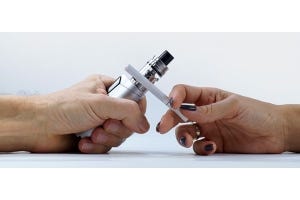Why Do I Vape More Than I Smoked?

When switching over from smoking to vaping, you might notice a few changes in the way you vape compared to the way you smoked. For instance, you might feel like you’re vaping more than you ever smoked.
If you’re in this situation, there are a few reasons why you might be vaping more than you smoked. It’s important to understand that vaping isn’t smoking. While vapes can offer a sense of familiarity for smokers looking to make the transition to vaping, they are entirely different products. Therefore, you might find yourself starting to form different habits around vaping than you had when smoking. However, just because you form different habits doesn’t necessarily mean there’s something to worry about.
Here, we dive into some of the main reasons why you might be vaping more than you smoked. We’ll also show you how to reduce your vaping - if that’s what you’re interested to know more about.
Convenience
In many ways, vapes can be more convenient and easier to use than cigarettes. Convenience is a big part of what makes vaping great. However, by being so easily accessible, it may mean you use the vape more than you might originally expect to.
A few convenience factors could be causing you to vape more than you smoked. These include the following.
Easier to Use Indoors
Some might find it easier to vape indoors compared to smoking, as it can raise less concerns about fire safety and health risks. Vaping is estimated to be much less of a health risk compared to smoking.1 Second-hand cigarette smoke is harmful to health, and you can expose others to it when smoking indoors.1 In contrast, there’s currently no evidence of harm caused by exposure to second-hand vape vapour.1
Vaping indoors can also be less of a fire risk than smoking.1 There are around 2,700 smoking-related fires in England each year.1 This is significantly more than the number of vaping-related fires caused by counterfeit or poorly crafted vape chargers.1 To learn more about vaping and fire safety, read our guide on The Truth About Vaping and Smoke Alarms.
All this considered could make you more inclined to vape indoors than you would have been to smoke. There’s less hassle involved in using your vape indoors compared to smoking outside, meaning you might find yourself vaping more, as there are fewer steps necessary to do so safely. While vaping indoors can be convenient, you should only ever vape indoors if it’s safe and allowed within the space.
Solution: If you find yourself vaping more because of the convenience of vaping indoors, why not start only vaping outside? This could make you more aware of when you’re vaping, and help better control your usage.
Less Weather-Dependent
The UK has banned smoking in enclosed public spaces,2 so when you’ve smoked in public, chances are this was outdoors. This can be a nuisance when the weather’s bad. You might’ve even been less inclined to go outside for a cigarette when it’s cold or raining. When it comes to public places, vaping doesn’t fall under the same restrictions as smoking.3
Without the bad weather keeping you from going outside, you could be vaping more than you smoked. That said, many enclosed public spaces still ask that you vape outside, so it’s always best to check with the venue whether you’re allowed to vape indoors. You can also find out more on this topic in our guide ‘Can I Vape Indoors?’
Fewer Moving Parts
Take disposable vapes for example, which are ready to use as soon as they come out of the pack. With most disposables, the user can simply draw on a disposable to start vaping. This can make it easier to vape, and therefore mean you tend to vape more than you would’ve smoked.
You also won’t need to carry extra items to use a disposable vape as you can have with a cigarette - e.g., a lighter, an ashtray, filters, rolling paper and tobacco. The seamless experience of vaping has fewer steps to it than smoking cigarettes - especially for those who roll their own cigarettes.
Even when taking the setup of rechargeable vapes into account, this can still be more convenient than smoking a cigarette. While you’ll have to change a coil, clean the vape and charge it up every now and then, you won’t have to do this every time you go for a vape.
Longer Lasting
When smoking, there’s a definite end point - with vaping, there’s not the same finite end. Most disposable vapes will last for an approximate amount of puffs - as many as 600 or more. Even when using rechargeable vapes, if the e-liquid is properly topped up you’ll typically find you can vape for much longer than you can smoke a single cigarette. Without a more clear-cut end to vaping, you might notice you continue to use the vape for longer than you can use a single cigarette, which can therefore lead to vaping more than you smoked.
Solution: It might help to give yourself a time limit for when you vape. This could give your vaping experience a more definitive end, so you don’t get carried away vaping more than you smoked. Some vapes also come with a puff count, such as the Vinci Pod Kit, so you can keep track of how many puffs you take. If you feel like you’re vaping too much, why not use a vape with this count feature and set yourself a limited amount of puffs for the day?
Nicotine Content in E-Liquids
One reason you could be vaping more than you smoked is because you aren’t using the best nicotine strength for your preferences. E-liquids come in a variety of different strengths and go up to 20 mg/ml in the UK. It’s great having such a variety of strengths to choose from, especially if you’ve just moved over from smoking to vaping and are new to the vaping world. However, it can be tricky knowing which strength is best suited to your needs.
If you choose an e-liquid with a lower nicotine strength than your preferences suit, you might vape more. One study found that those who used lower nicotine strengths in their vape consumed more of it than a group who used higher strengths.4 That said, when it comes to nicotine vaping, it’s all down to personal preference. Choosing a higher nicotine-strength e-liquid won’t necessarily mean you vape less.
Solution: Looking into the different e-liquid nicotine strengths can help you make a more informed decision on which one is right for you. If you were a heavy smoker, you might find that higher nicotine strengths such as 18 mg and 20 mg are best to consider. Read our guide on The Best Vapes for Heavy Smokers for further information. Alternatively, if you were a lighter smoker, lower strengths like 3 mg might be better suited to your tastes.
Finding the right nicotine strength is a learning process, and you may find that you have to try a few out before getting the right balance. If you’re just getting started on your vaping journey, we’re always on hand to help guide you through the process. Get in touch to chat with a member of our experienced vaping team.
The nicotine level you’re vaping at isn’t the only factor that can affect the satisfaction of your vaping experience. While nicotine salts offer a smooth throat hit with high 18 mg and 20 mg nicotine strengths, other 50/50 e-liquids with high amounts of nicotine can bring a harsher throat hit. Therefore, it’s a good idea to explore the other elements of e-liquid that can impact your overall experience.
Do All Vapes Have Nicotine?
No, not all e-liquids will contain nicotine. Some e-liquids even come nicotine-free. These are what’s known as shortfills, you can find out more about them in our guide to Shortfill E-Liquid: What It Is and How to Use It.
Do Vapes Have More Nicotine Than Cigarettes?
Vapes can have more nicotine than cigarettes. However, with such a variety of nicotine strengths available for e-liquids, this isn’t clear-cut. The amount of nicotine in cigarettes can also vary. However, a single cigarette can have a nicotine content of anywhere from 8 - 20 mg, the average being 12 mg per cigarette.
Social and Cultural Factors
If you’ve ever found yourself wondering ‘is vaping the same as smoking?’ the answer is no - and it’s common knowledge that it’s not. The negatives of smoking and how it compares to vaping are widespread and could be a reason why some people find themselves vaping more than they ever smoked.
There’s lots of information online about the negative effects of smoking, and moreover how smoking can seriously impact your health. Cigarette smoke releases thousands of chemicals, many of which are damaging to the user’s health.5 Vaping exposes people to a lot less toxins than smoking cigarettes.5 What’s more, vaping doesn’t produce carbon monoxide or tar, which are some of the most harmful substances of tobacco smoke.5
Vaping can also cost less than smoking. Once you’ve purchased your vape kit, it’s estimated that vaping is around a third of the cost of smoking.5 There’s also a Swap to Stop scheme in the UK where smokers can get free vapes to help them stop smoking. While vaping can be more cost-effective than smoking, this is only the case if you’re cost-conscious about your vape purchases. For example, disposable vapes are great to help test whether you like vaping. However, they’re not cost-effective in the long run, and after you’ve tested vaping out with disposables, it’s worth looking into a more long-term solution, like rechargeable vapes.
Many find vaping more socially acceptable than smoking. What’s more, lots of vapers prefer the taste of vaping to smoking too - especially with the huge variety of vape juice flavours available! If you want to learn more about vaping, we’ve got lots of other useful guides on this topic on our blog.
Sources:
- RoSPA, ‘Use of e-cigarettes (vaping) in the home: advice for parents’ - https://www.rospa.com/rospaweb/docs/advice-services/home-safety/vaping-in-the-home-advice-for-parents.pdf
- Gov.uk, ‘Health Act 2006’ - https://www.legislation.gov.uk/ukpga/2006/28/pdfs/ukpga_20060028_en.pdf
- Gov.uk, - ‘Use of e-cigarettes in public places and workplaces’ https://assets.publishing.service.gov.uk/government/uploads/system/uploads/attachment_data/file/768952/PHE-advice-on-use-of-e-cigarettes-in-public-places-and-workplaces.PDF
- National Library of Medicine, ‘Why Less is More: Vaping Low-Nicotine vs. High-Nicotine E-Liquid is Compensated by Increased Wattage and Higher Liquid Consumption’ - https://www.ncbi.nlm.nih.gov/pmc/articles/PMC6427796/
- NHS, ‘Vaping to quit smoking’ - https://www.nhs.uk/better-health/quit-smoking/vaping-to-quit-smoking/














